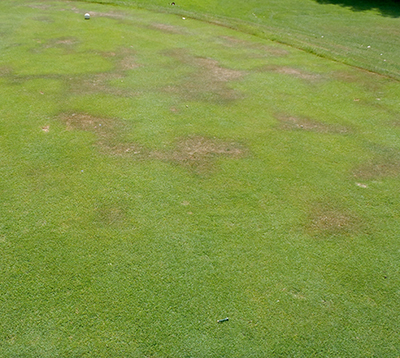The heat is on: Protect golf course turf during high temperatures
High temperatures will stress turfgrass in the next week. Here are simple reminders as the heat ramps up.

High temperatures and heat indexes have been stressing both us and turfgrass lately. Michigan State University Extension offers some simple reminders as the heat ramps up.
Check the irrigation system
This may seem obvious, but it might not be a bad idea to go out and observe the irrigation system operating in critical areas. Inefficiencies, misaligned, or malfunctioning heads that may have been disguised by cooler temperatures or rainfall to this point in the season will not be anymore. Areas that reveal poor irrigation coverage first are typically edges of fairways, banks of greens, tees, bunkers and the rough. Many of these areas are also high traffic areas that are subject to compaction—another stress.
Syringing
To compensate for poor irrigation coverage and improve water management, hand watering is commonplace on golf courses. In Michigan, we are accustomed to syringing greens during periods of drought, but usually not fairways.
The late Joe Vargas, PhD, would often remind me that in Mediterranean climates like southern Europe, where it does not rain from the middle of May until the middle of September and the temperatures are in the 90s every day, the superintendent will usually have three or more people assigned every day to syringe fairways. When we have similar conditions, it may become necessary to syringe fairways. We’re not necessarily talking about the hose crew, but rather a short irrigation cycle.
It is commonly perceived that noon is the warmest part of the day, when it is often around 4 to 6 p.m. Syringing late in the afternoon might make the difference this year between healthy and heat-stressed turf.
Adjusting management practices
This is the time to consider adjusting daily management practices such as mowing to minimize stress. If ever there was a time to raise mowing heights or substitute rolling for mowing, this is it. Superintendents might even skip mowing altogether, there’s not as much top growth to slow down green speeds during these high temperatures, and there probably aren’t going to be as many golfers out on the course to complain anyway.
Heat tracking
Heat tracks will be an issue on home lawns and golf courses. Anytime you put traffic from a cart, mower or spreader on turf that is nearing the wilting point or has already wilted, you will likely see a track in the following days or week. If possible, avoid mowing during the heat of the afternoon.
Wetting agents
Wetting agents are critical tools in the arsenal for alleviating localized dry spot. However, even with wetting agents, hand-watering may be necessary during this stretch of hot weather.

Scout and plan for diseases
The record high temperatures we’re experiencing are accompanied by high humidity and high temperatures at night that in some locations have remined in the 80s. Conditions are favorable for dollar spot, brown patch and Pythium diseases including Pythium blight, root rot, and root dysfunction. Vargas wrote an article on pythium root rot diseases that mirrors some of the weather patterns we’re experiencing this year. In 2019, a spring with excessive rainfall caused Pythium root rot diseases to become a problem. The Pythium species are water molds so the excessive rainfall earlier this season may have enhanced their occurrence. Now add high temperature, stress and turf may be struggling in some areas.
Pythium blight is not normally treated for on a regular basis in Michigan, but when daytime high temperatures are in the 90s and night temperatures above 70 degrees Fahrenheit following a rain, chances are optimal for a Pythium blight outbreak. If caught in time, the turf should recover from the dollar spot, brown patch and Pythium blight, which are primarily foliar diseases.
Crown rot anthracnose can also be a problem in warm weather on annual bluegrass greens, especially if the warm weather is accompanied by excess moisture from frequent rains. Widespread resistance of Colletotrichum cereale, the crown rot anthracnose fungus, to the benzimidazole and the Qo I fungicides has been reported.
Alternative fungicide chemistries should be used to control crown rot anthracnose. Adequate nitrogen fertility is also necessary to control this disease.
Annual bluegrass weevil
Keep in mind that annual bluegrass weevil has now been identified on several golf courses in Michigan, especially in the Detroit area. Scout wilting collars and edges of fairways for annual bluegrass weevil larvae to confirm you’re not dealing with annual bluegrass weevil, but either diseases or simple high temperature stress.
Hydrate—drink plenty of fluids
Just a reminder to keep yourself hydrated during the hot weather. There are bound to be some long days and if you’re acclimated to cooler weather, temperatures in the 90s may cause us to wilt as much as the turf.



 Print
Print Email
Email
